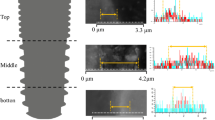Abstract
The aim of the study was to evaluate early osseointegration of the laser-treated and acid-etched implant surface after the installation in rabbit tibias for 4 weeks. A total of 56 screw-shaped implants were grouped as follows: group A: implants were turned surface; group B: implants were laser-treated surface; group C: implants were acid-etched; group D: Implants were laser-treated and acid-etched surface. After 4 weeks, the removal torques were: group A: 13.21 ± 11.30 Ncm; group B: 29.73 ± 8.32 Ncm; group C: 30.31 ± 9.45 Ncm; group D: 35.76 ± 7.58 Ncm; The averages of bone-to-implant contact (BIC) were as follows: group A: 27.30 ± 6.55%; group B: 38.00 ± 8.56%; group C: 42.71 ± 8.48%; group D: 49.71 ± 9.21%. The removal torque and bone-to-implant contact measurements yielded statistically significant differences between the treated groups and turned group (P < 0.05); The laser-treated and acid-etched surface achieved higher Bone-to-Implant Contact than the laser-treated surface (P < 0.05), but there was no statistically significant difference between the laser-treated and acid-etched surface and the acid-etched surface in bone-to-implant contact (P > 0.05). In the present study, it was concluded that the laser-treated and acid-etched implants had good osteoconductivity and was a potential material for dental implantation.




Similar content being viewed by others
References
DM Brunette. The effects of implant surface topography on the behavior of cells. Int J Oral Maxillofac Implant. 1998;3:231–46.
Kieswetter K, Schwartz Z, Dean DD, Boyan BD. The role of implants surface characteristics in the healing of bone. Crit Rev Oral Biol Med. 1996;7:329–45.
Sanmmons R, Lumbikanonda N, Cantzler P. Osteroblast interactions with a FRIADENT experimental surface and other microstructured dental implant surfaces. Scientific Poster: 10th International FRIADENT symposium, Mannheim/Heidelberg, Germany, May 16–17, 2003.
Hofmann AA, Bloebaum RD, Bachus KN. Progression of human bone ingrowth into porous-coated implants. Acta Orthop Scand. 1997;68:161–6.
Hall J, Miranda-burgos P, Sennerby L. Stimulation of directed bone growth at oxidized titanium implants by macroscopic grooves: an in vivo study. Clin Implant Dent Relat Res. 2005;7:76–82.
Mangano C, Perrotti V, Iezzi G, Scarano A, Mangano F, Piattelli A. Bone response to modified titanium surface implants in nonhuman primates (Papio ursinus) and humans: histological evaluation. J Oral Implantol. 2008;34(1):17–24.
Schwartz Z, Martin JY, Dean DD, Simpson J, Cochran DL, Boyan BD. Effect of titanium surface roughness on chondrocyte proliferation, matrix production and differentiation depends on the state of cell maturation. J Biomed Mater Res. 1996;30:145–55.
Hallgren C, Reimers H, Chakarov D, Goldb J, Wennerberg A. An in vivo study of bone response to implants topographically modified by laser micromachining. Biomaterials. 2003;24:701–9.
Gaggl A, Schultes G, Müller WD, et al. Scanning electron microscopical analysis of laser-treated titanium implants surfaces: a comparative study. Biomaterials. 2000;21:1067–71.
Sullivan DY, Sherwood RL, Mai TN. Preliminary results of a multicenter study evaluating a chemically enhanced surface for machined commercially pure titanium implants. J Prosthet Dent. 1997;78:379–86.
Gold J. Microfabrication for biological applications, Ph.D. thesis, Chalmers University of Technology, Department of Applied Physics, Goteborg, Sweden, 1996.
Bugea C, Luongo R, Di Iorio D, et al. Bone contact around osseointegrated implants: histologic analysis of a dual-acid-etched surface implant in a diabetic patient. Int J Periodontic Restor Dent. 2008;28:145–51.
Fernandes Ede L, Unikowski IL, Teixeira ER, et al. Primary stability of turned and acid-etched screw-type implants: a removal torque and histomorphometric study in rabbits. Int J Oral Maxillofac Implant. 2007;22:886–92.
Cho S-A, Jung S-K. A removal torque of the laser-treated titanium implants in rabbit tibia. Biomaterials. 2003;24:4859–63.
Dong-Sheng W. Modified method of making ground section of bone with dental implant. Chin J Prosthodont Chin J Prosthodont. 2006;3:169–70.
Jartoft P, Kinoform MK. Guided laser microfabrication of titanium implant surfaces. Master thesis, Department of Applied Physics, Chalmers University of Technology, Goteborg, Sweden.
Ari I, Ylanen OH, Ekholm C, Karlsson KH, Aro HT. Pore diameter of more than 100 μm is not requisite for bone ingrowth in rabbits. J Biomed Mater Res. 2000;58:679–83.
Rupp F, Scheideler L, Rehbein D, Axmann D, Geis-Gerstorfer J. Roughness induced dynamic changes of wettability of acid etched titanium implant modifications. Biomaterial. 2004;25:1429–38.
Wennerberg A. On surfaceroughness, implant incorporation. G.oteborg: Department of Biomaterials/Handicap Research, G.oteborg University; 1996.
Rønold HJ, Lyngstadaas SP, Ellingsen JE. Analysing the optimal value for titanium implant roughness in bone attachment using a tensile test. Biomaterials. 2003;24:4559–64.
Germanier Y, Tosatti S, Broggini N, Textor M, Buser D. Enhanced bone apposition around biofunctionalized sandblasted and acid-etched titanium implant surfaces a histomorphometric study in miniature pigs. Clin Oral Impl Res. 2006;17:251–7.
Lang Niklaus P. Healing sequeces during tissue integration of ITI implants-analysis of early morphogenesis. Congress, Fuzhou, September 9, 2007.
Cho S-A, Park K-T. The removal torque of titanium screw inserted in rabbit tibia treated by dual acid etching. Biomaterials. 2003;24:3611–7.
Acknowledgements
Project name: (1) National Science/Technology Pillar Program in the Eleventh Five-year Plan Period. Serial number: 2007BAI18BO6; (2) Science and Technology Three Item of Funds Plan Project of Guangdong Province. Serial number: 2006B19901006. This work was supported by the Guangdong Provincial Stomatological Hospital (Southern Medical University, China) and Guangdong Medical College.
Author information
Authors and Affiliations
Corresponding author
Rights and permissions
About this article
Cite this article
Rong, M., Zhou, L., Gou, Z. et al. The early osseointegration of the laser-treated and acid-etched dental implants surface: an experimental study in rabbits. J Mater Sci: Mater Med 20, 1721–1728 (2009). https://doi.org/10.1007/s10856-009-3730-4
Received:
Accepted:
Published:
Issue Date:
DOI: https://doi.org/10.1007/s10856-009-3730-4




